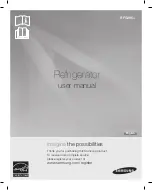
5
Electrical Requirements
Before you move your refrigerator into its final location, it is
important to make sure you have the proper electrical
connection.
Recommended grounding method
A 115 Volt, 60 Hz., AC only 15 or 20 ampere fused, grounded
electrical supply is required. It is recommended that a separate
circuit serving only your refrigerator be provided. Use an outlet
that cannot be turned off by a switch. Do not use an
extension cord.
NOTE: Before performing any type of installation, cleaning, or
removing a light bulb, turn the control (Thermostat, Refrigerator
or Freezer Control depending on the model) to OFF and then
disconnect the refrigerator from the electrical source. When you
are finished, reconnect the refrigerator to the electrical source
and reset the control (Thermostat, Refrigerator or Freezer Control
depending on the model) to the desired setting.
Water Supply Requirements
Read all directions carefully before you begin.
IMPORTANT:
■
If you turn the refrigerator on before the water line is
connected, turn the ice maker OFF.
■
All installations must meet local plumbing code requirements.
■
Use copper tubing and check for leaks. Install copper tubing
only in areas where the household temperatures will remain
above freezing.
Tools Required: Flat-blade screwdriver,
⁷⁄₁₆
in. and
¹⁄₂
in. open-
end wrenches or two adjustable wrenches,
¹⁄₄
in. nut driver and
drill bit, hand drill or electric drill (properly grounded).
NOTE: Your refrigerator dealer has a kit available with a
¹⁄₄
in.
(6.35 mm) saddle-type shutoff valve, a union, and copper tubing.
Before purchasing, make sure a saddle-type valve complies with
your local plumbing codes. Do not use a piercing-type or
³⁄₁₆
in.
(4.76 mm) saddle valve which reduces water flow and clogs more
easily.
Water Pressure
A cold water supply with water pressure of between 30 and 120
psi (207-827 kPa) is required to operate the water dispenser and
ice maker. If you have questions about your water pressure, see
“Troubleshooting” or call a licensed, qualified plumber.
Reverse Osmosis Water Supply
If a reverse osmosis water filtration system is connected to your
cold water supply, the water pressure to the system needs to be
a minimum of 40 to 60 psi (276 - 414 kPa).
If the water pressure to the reverse osmosis system is less than
40 to 60 psi (276 - 414 kPa) a booster pump can be inserted into
the small tubing that goes from the cold water line to the reverse
osmosis system.
If the water dispenser is still not dispensing water properly:
■
Check to see whether the sediment filter in the reverse
osmosis system is blocked. Replace the filter if necessary.
■
Allow the storage tank on the reverse osmosis system to refill
after heavy usage.
■
If your refrigerator has a water filter cartridge, it may further
reduce the water pressure when used in conjunction with a
reverse osmosis system. Remove the water filter cartridge.
See “Water Filtration System.”
If you have questions about your water pressure, refer to
“Troubleshooting” or call a licensed, qualified plumber.
Base Grille
To remove the base grille:
1. Open both doors.
2. Place hands along the ends of the grille. Push in on the top
and pull up on the bottom.
NOTE: Be sure to refasten the Tech Sheet behind the base grille
after cleaning.
To replace the base grille:
1. Open both doors.
2. Line up the grille support tabs with the metal clips.
3. Push the grille firmly to snap it into place.
WARNING
Electrical Shock Hazard
Plug into a grounded 3 prong outlet.
Failure to follow these instructions can result in
death, fire, or electrical shock.
Do not use an extension cord.
Do not use an adapter.
Do not remove ground prong.






































